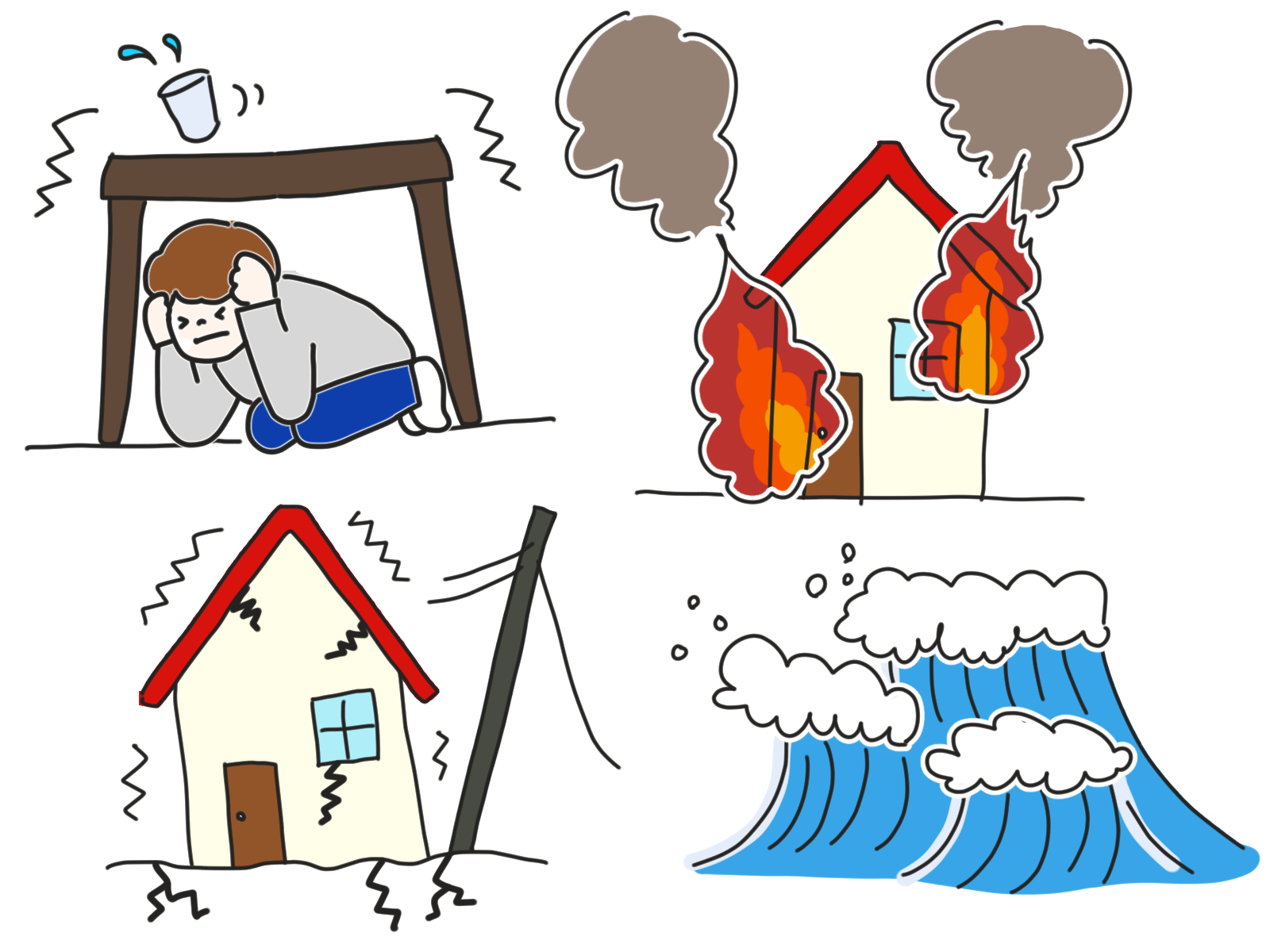- Introduction
- 1. Prepare for earthquakes
- Items to take with you when evacuating
- Things to keep at home at all times
- Check the location of shelters near where you live.
- Evacuation Centers <Places to Take Refuge at>
- Safety measures at home
- ISOGO Evacuation Center Map
- Confirmation of safety when a major earthquake occurs
- Multilingual support site for foreigners in case of disaster
- 2.Prepare for flooding
- 3.How to protect your life from fire
Introduction
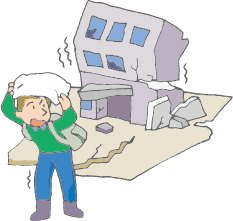
Japan is a country with many earthquakes.Many natural disasters (earthquakes, heavy rains, typhoons) occur in Japan, causing major damage.No one knows when a natural disaster will occur.
Therefore, each person and their family must make preparations.
1. Prepare for earthquakes
Items to take with you when evacuating
1.Cash

2.Bankbooks

3.Personal seals

4.Passport

5.Resident card

6.Insurance card

7.Lighter or matches

8.Flashlight

9.Spare batteries

10.Mobile phone

11.Radio

12.Medications

13.Prescriptionrecord booklet

14.Clothes, underwear

15.Water, food * Only what you can carry

Things to keep at home at all times
* Supplies for more than 3 days
1.Drinkingwater Approximately 3 liters per person per day x 3 days’ worth

2.Food Approximately 3 meals per person per day x 3 days’ worth
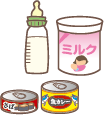
3.Portabletoilet packs Approximately 5 packs per person per day x 3 days’ worth

Check the location of shelters near where you live.
Do not evacuate by car.
If your home is not at risk of fire or collapse, stay in your home.
Evacuation Centers <Places to Take Refuge at>
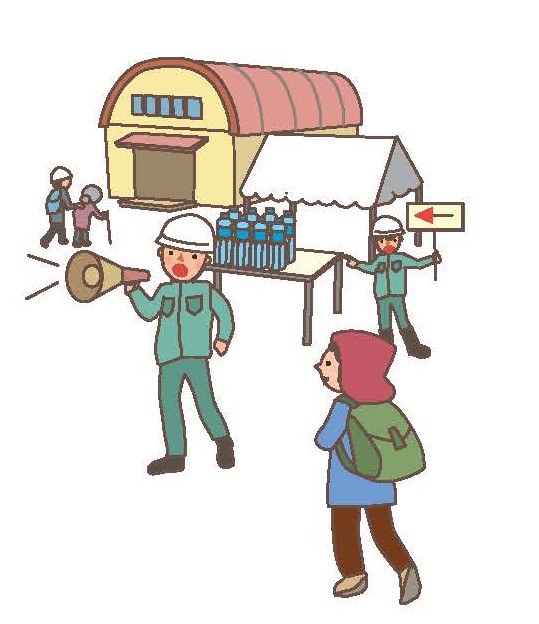
- Park
- Elementary school
- Junior high school
A place where you can live as an evacuee if you cannot live at home due to fire or collapse.
You will be able to obtain the minimum necessary amount of food and water there.
Also, a place where you can obtain needed information.

- Evacuation Area
A temporary evacuation area where you can take refuge from the heat and smoke of a major fire.
No food or water will be available.
Safety measures at home
Secure furniture to prevent it from falling over.
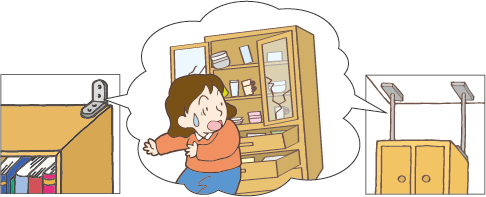
ISOGO Evacuation Center Map
Confirmation of safety when a major earthquake occurs
Make arrangements ahead of time with family and friends to escape together.
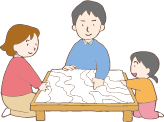
1.Leave a voice message at the Disaster Emergency Message Dial “171” voice mail service.
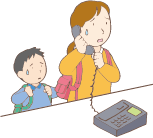
【Practice Days】
· 1st and 15th of every month, 00:00-24:00
· First 3 days of new year (January 1 from 00:00 to January 3 until 24:00)
· Disaster Prevention Week (August 30, 9:00 to September 5, 17:00)
· Disaster Prevention and Volunteer Week (January 15, 9:00 to January 21, 17:00)
2.Contact using a mobile phone or the Internet
・”Disaster message board service” of mobile phone companies
・X
・LINE
・NTT East’s “Disaster Emergency Message Dial”
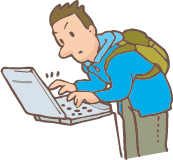
Addresses of sites explaining disaster message board services of mobile phone companies
NTT https://www.docomo.ne.jp/info/disaster/disaster_board/index.html
SoftBank https://www.softbank.jp/mobile/service/dengon/boards/
KDDI(au) https://www.au.com/mobile/anti-disaster/saigai-dengon/
Y!mobile https://www.ymobile.jp/service/dengon/
Multilingual support site for foreigners in case of disaster
1.Kanagawa International Foundation
公益財団法人 かながわ国際交流財団 災害時の多言語支援情報サイト
Kanagawa Community Network Site
2.Yokohama Association for International Communications and Exchanges (YOKE)
2.Prepare for flooding
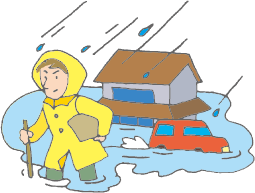
・If you live near a river, it is important that you evacuate based on your judgment in the case of heavy rain, guerrilla rainstorm (localized downpour of short duration), or a typhoon.
・People who live near a river must take early action before danger approaches.
Items to take with you when evacuating
・Same as for earthquakes

Evacuation Centers
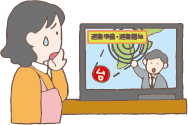
・Schools in the neighborhood where there is no danger of flooding will serve as evacuation centers.
・Evacuation centers will start to operate as such from the time government authorities make an announcement to this effect.
・The evacuation center locations and contact information will be given out on television, public announcement vehicles, etc.
・Collect information.
・Do not evacuate by car.
3.How to protect your life from fire

How to evacuate (How to escape from smoke)
(1)What is smoke?

Smoke from fire is hot and contains toxic gases that spread out upwards (ceiling).
(2)How not to breathe in smoke
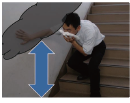
Keep low, breathe the air near the floor, and cover your mouth and nose with a handkerchief.
(3)Places to evacuate to
If you can escape, evacuate to the ground floor. If you cannot evacuate to the ground floor, evacuate to a place that does not have smoke, like a balcony.
How to extinguish a fire (How to use a fire extinguisher)
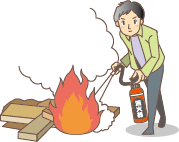
A fire can be extinguished while its flames are still small.
Therefore, it is important to have a fire extinguisher ready for use and also to learn how to use it.
1.Notify the people around you in a loud voice.

2.Pull the yellow safety pin upward and out.

3.Hold the hose and point it to the source of the fire.

4.Strongly press down the lever.

How to call a fire engine/ambulance
Multilingual Service

When you call 119, there will be English, Chinese, Korean, Spanish and Portuguese interpreters available.
1.Call 119.
2.Indicate whether you are calling to report a fire or an emergency.
3.Tell the operator the address the fire truck or ambulance should go to.
4.Answer any questions you are asked by the operator.
5.Tell the operator your phone number and name.


